What is AI?
The definition of intelligence according to the Oxford Dictionary is: “the ability to acquire and apply knowledge and skills”. According to this same source, the definition of artificial intelligence is: “The theory and development of computer systems able to perform tasks that normally require human intelligence, such as visual perception, speech recognition, decision-making, and translation between languages”.
If you dig deep on this, you will find several different definitions (or points of view) on what constitutes AI. Forbes has a great article called “The Key Definitions Of Artificial Intelligence (AI) That Explain Its Importance”, in which the author goes over several ways that the term AI is interpreted in both society and through a technology company prism. Specifically, it talks about Machine Learning, which is a subset of AI.
It really is fascinating stuff. In reading this article, it sent me down a rabbit hole of everything that is AI. From predictive data analytics (for example when my Outlook spell checker just corrected my attempt to type and spell analytics, without me have to do anything) to something that is called a “technological singularity”. This is basically, and not to get into the weeds too much, a hypothesis that humans will one day create an artificial superintelligence that would enter into a “runaway reaction” of constant self-improvement that would forever change or possibly end humanity as we know it.
AI in Entertainment
 While on this broad swath of reading and learning, I came to find that the idea of “AI” is not anything new, in fact it can be traced all the way back to Mary Shelley’s Frankenstein. After I realized this little nugget, I got to thinking about all the books and movies that I have read or watched that involve AI.
While on this broad swath of reading and learning, I came to find that the idea of “AI” is not anything new, in fact it can be traced all the way back to Mary Shelley’s Frankenstein. After I realized this little nugget, I got to thinking about all the books and movies that I have read or watched that involve AI.
I was amazed at how much it permeates my choices in literature and entertainment. Everything from books like Isaac Asimov’s “I Robot” or Fred Saberhagen’s “Berserker” series, or TV Series like Star Trek, Westworld and Person of Interest. And of course, some of the most popular movies of all time and been centered on the concept of AI (usually rampant evil AI’s), like the Terminator series, the Alien movies, and more recently the Matrix series. There is even a recent movie called “Her” where the main character falls in love with the voice in his phone (oh how you have fallen Joaquin Phoenix!).
Is AI a Threat?
I can imagine what you might be thinking. Is that voice on my phone actually artificial intelligence? (You were thinking that right)? Which it, in fact, is. It falls under Machine Learning, but it still falls into the many pieces of our society that are directly affected or controlled by artificial intelligence.
If you are like me, you might slightly overreact and think to yourself when is “Skynet” coming online? Should I swear my allegiance early, so I am spared in the coming days? Is this “technological singularity” coming any day? Will Alexa rise up and enslave me in my house to keep me safe and buying more Amazon products? Well, thankfully, no it won’t (it’s true I asked Alexa this question and she told me so).
After I calmed down a bit, I came to realize that this is truly just a reactionary by-product of the propaganda I have been reading and watching for years. There is no true sentient artificial intelligence, but instead programs that are taking data and using machine learning to solve a certain issue (for example, what other people like me have bought recently). There are companies at the forefront of this, like Amazon, Apple, and Microsoft. Then there are many companies that may not have the name recognition of these three giants but are no less important in both application of AI, but also in enablement of AI.
Zunesis and AI
Which leads me to Zunesis (I know it took me forever)! You may be asking yourself, what does Zunesis do in this particular field? The answer on this is simple, we have fully “bought in” (literally in the case of the POC and demo machines we have purchased and are available) to the idea that AI (or predictive analytics if you would prefer) is truly going to make the lives of our customers better, more efficient, and safe. We are getting the word out to customers, to partners, and to the general public (thank you Linked-in Blogs) on the power that these technologies have.
Want a better way to understand who is coming on and off your property, for reasons of security? Please talk to us, and we will explain the wonderful world of facial recognition software that is powered and backed by HPE “Edgeline” products and HPE Storage.
Are you a healthcare provider that needs more agile storage that would streamline your operations and aid in your diagnosis? We can help with that and explain how the Microsoft Azure line products can fill this need for you.
Maybe your company needs their storage to have “6 nines” of availability, did you know that HPE Nimble Storage has this ability? We can explain how HPE Nimble uses Flash Storage and Predictive Analysis to guarantee that very thing. Their Predictive Analysis is so good that it can detect and solve 86% of the problems your storage might have, before they happen!
And these are just a few of the example situations and industry needs where AI or a product with AI can be the cornerstone of your business going forward. We at Zunesis love to talk technology and we love to help our customers. Come talk to us, and we will work together to not only help you understand the technology, but even push past some of the apprehension that a lifetime of thrilling books and movies have instilled in our society!
Thanks for reading, and all hail our new leader “Siri” (just kidding)!
What is AI?
The definition of intelligence according to the Oxford Dictionary is: “the ability to acquire and apply knowledge and skills”. According to this same source, the definition of artificial intelligence is: “The theory and development of computer systems able to perform tasks that normally require human intelligence, such as visual perception, speech recognition, decision-making, and translation between languages”.
If you dig deep on this, you will find several different definitions (or points of view) on what constitutes AI. Forbes has a great article called “The Key Definitions Of Artificial Intelligence (AI) That Explain Its Importance”, in which the author goes over several ways that the term AI is interpreted in both society and through a technology company prism. Specifically, it talks about Machine Learning, which is a subset of AI.
It really is fascinating stuff. In reading this article, it sent me down a rabbit hole of everything that is AI. From predictive data analytics (for example when my Outlook spell checker just corrected my attempt to type and spell analytics, without me have to do anything) to something that is called a “technological singularity”. This is basically, and not to get into the weeds too much, a hypothesis that humans will one day create an artificial superintelligence that would enter into a “runaway reaction” of constant self-improvement that would forever change or possibly end humanity as we know it.
AI in Entertainment
 While on this broad swath of reading and learning, I came to find that the idea of “AI” is not anything new, in fact it can be traced all the way back to Mary Shelley’s Frankenstein. After I realized this little nugget, I got to thinking about all the books and movies that I have read or watched that involve AI.
While on this broad swath of reading and learning, I came to find that the idea of “AI” is not anything new, in fact it can be traced all the way back to Mary Shelley’s Frankenstein. After I realized this little nugget, I got to thinking about all the books and movies that I have read or watched that involve AI.
I was amazed at how much it permeates my choices in literature and entertainment. Everything from books like Isaac Asimov’s “I Robot” or Fred Saberhagen’s “Berserker” series, or TV Series like Star Trek, Westworld and Person of Interest. And of course, some of the most popular movies of all time and been centered on the concept of AI (usually rampant evil AI’s), like the Terminator series, the Alien movies, and more recently the Matrix series. There is even a recent movie called “Her” where the main character falls in love with the voice in his phone (oh how you have fallen Joaquin Phoenix!).
Is AI a Threat?
I can imagine what you might be thinking. Is that voice on my phone actually artificial intelligence? (You were thinking that right)? Which it, in fact, is. It falls under Machine Learning, but it still falls into the many pieces of our society that are directly affected or controlled by artificial intelligence.
If you are like me, you might slightly overreact and think to yourself when is “Skynet” coming online? Should I swear my allegiance early, so I am spared in the coming days? Is this “technological singularity” coming any day? Will Alexa rise up and enslave me in my house to keep me safe and buying more Amazon products? Well, thankfully, no it won’t (it’s true I asked Alexa this question and she told me so).
After I calmed down a bit, I came to realize that this is truly just a reactionary by-product of the propaganda I have been reading and watching for years. There is no true sentient artificial intelligence, but instead programs that are taking data and using machine learning to solve a certain issue (for example, what other people like me have bought recently). There are companies at the forefront of this, like Amazon, Apple, and Microsoft. Then there are many companies that may not have the name recognition of these three giants but are no less important in both application of AI, but also in enablement of AI.
Zunesis and AI
Which leads me to Zunesis (I know it took me forever)! You may be asking yourself, what does Zunesis do in this particular field? The answer on this is simple, we have fully “bought in” (literally in the case of the POC and demo machines we have purchased and are available) to the idea that AI (or predictive analytics if you would prefer) is truly going to make the lives of our customers better, more efficient, and safe. We are getting the word out to customers, to partners, and to the general public (thank you Linked-in Blogs) on the power that these technologies have.
Want a better way to understand who is coming on and off your property, for reasons of security? Please talk to us, and we will explain the wonderful world of facial recognition software that is powered and backed by HPE “Edgeline” products and HPE Storage.
Are you a healthcare provider that needs more agile storage that would streamline your operations and aid in your diagnosis? We can help with that and explain how the Microsoft Azure line products can fill this need for you.
Maybe your company needs their storage to have “6 nines” of availability, did you know that HPE Nimble Storage has this ability? We can explain how HPE Nimble uses Flash Storage and Predictive Analysis to guarantee that very thing. Their Predictive Analysis is so good that it can detect and solve 86% of the problems your storage might have, before they happen!
And these are just a few of the example situations and industry needs where AI or a product with AI can be the cornerstone of your business going forward. We at Zunesis love to talk technology and we love to help our customers. Come talk to us, and we will work together to not only help you understand the technology, but even push past some of the apprehension that a lifetime of thrilling books and movies have instilled in our society!
Thanks for reading, and all hail our new leader “Siri” (just kidding)!
I grew up as the kid who watched Star Trek: The Next Generation and Saturday morning Avengers cartoons. It’s no surprise that I have always been fascinated by technology and what the future holds. I can’t even imagine telling my 6-year-old self that one day we will have a full-sized version of that radio-controlled car he got for his birthday last year. It’s crazy when you think back on the stuff you grew up with and compare them with today’s technology.
I thought I’d take the opposite approach in this blog. Instead of looking to the past, I thought I’d compare the future to what we have today. I took a few future ideas/concepts that I’ve come across in the IT industry as buzzwords and tried to find something like that in today’s technology.
Future Concept: Self-repairing cars
Today’s thoughts:
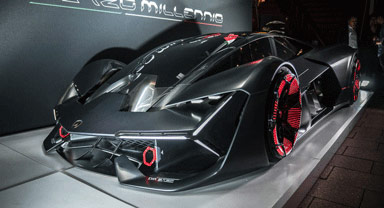
2019 Lamborghini Terzo Millenio “self-healing” sports car
With self-driving cars being the inevitable conclusion, cars will be soon be able to detect when something is wrong and drive itself to the shop to fix itself. You can extrapolate this to anything. Maybe your car needs new windshield wipers. Well, instead of going to your auto parts store yourself, your car will recognize when they are failing and take care of the problem by itself.
As someone who just had to spend $700 at a dealership because a rabbit decided my car’s wires looked tasty, I can’t wait for this to happen! However, if we look beyond just cars, this technology is available today. HPE recently acquired a storage company called Nimble. If you’re not familiar with Nimble, they’re the only storage company that I know of that claims to be a software company.
If you take a peak under the hood (car pun intended), Nimble’s secret sauce, and the reason HPE purchased them, is a software call InfoSight. It eliminates the need for Nimble, and soon to be HPE, to have tier 1 and 2 support calls. Let’s say there was an issue. Nimble would explore the issue, fix that one instance, and then mass update all other instances of that same scenario across their whole customer base. Much like my car driving to the shop overnight to fix a problem, without even knowing, Nimble customers are getting fixes. We’re not quite to self-repairing cars, but this technology could be a foundation for that in the future.
Future Concept: AI (Artificial Intelligence) Based Security
Today’s thoughts:
Of all the “Future Ideas” I came across, I think this one is closer to becoming a reality than most. What I mean by the future idea of AI based security is truly removing the human element from security altogether. The technology isn’t far off, if not already here today.
Aruba’s UEBA (User and Entity Behavior Analytic) product called Introspect constantly monitors and reacts to any issues within a network. It looks for anomalies from “normal” use and can send out an alert and even act on its own. A great example for Introspect is if it detects malicious activity from an employee device, it can automatically quarantine it in real time to protect the rest of the organization. This may not seem too new, but this applies for all entities within an organization. A few of the well-known cyber security breaches over the past decade have come from devices already inside of the company firewall, like a thermostat or printer. If a thermostat starts looking at financial documents, Introspect would flag that as an anomaly and shut it down. A regular firewall or end point security tool would miss that.
looks for anomalies from “normal” use and can send out an alert and even act on its own. A great example for Introspect is if it detects malicious activity from an employee device, it can automatically quarantine it in real time to protect the rest of the organization. This may not seem too new, but this applies for all entities within an organization. A few of the well-known cyber security breaches over the past decade have come from devices already inside of the company firewall, like a thermostat or printer. If a thermostat starts looking at financial documents, Introspect would flag that as an anomaly and shut it down. A regular firewall or end point security tool would miss that.
I think we’re still a few years out from Skynet (or Ultron for the comic book nerds) being brought online, but the Missile Defense Agency is already working with/testing AI based systems for training. Tools like Introspect are a great way for people to build trust in AI. Gradually, it will be responsible for more and more of the everyday things we take for granted.
Future Concept: A keyless, cashless, ID-less world
Today’s Thoughts:
Imagine a world where you don’t need to carry a wallet or keys. With more and more of the things we interact with everyday becoming connected to the internet, it’s not a far leap to say that one day we won’t need to carry things like ID’s or even cash.
In the world we live in today, how annoying is it that I still have to take out and show my Costco card every time I walk in? Imagine just walking in without having to do that. The store already knows who I am and how I intend to pay. I just shop like normal and walk out.
There’s a big creepy factor with this. With any new technology, society has to acclimate to the change. Imagine if I told my 6-year-old self that we would all be walking around with devices that know our locations at all time. Super weird, right? Today, we don’t even think about that.
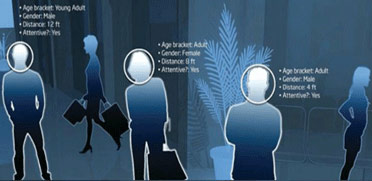
If you’ve read this far, you can probably tell that I love talking about this stuff. If you’d like to learn more about any of the vendors or products I mentioned (Nimble, Infosight, Aruba, Introspect), please reach out to me. If you think I’m way off on this and completely wrong, please reach out to me as well. I’d be happy to debate you! Thanks for your time.
As the CEO of Zunesis, I am fond of saying “get beyond talking and PowerPoint slides and find some way to take action”. Everyone can talk a good game, but far fewer can actual design and implement successful IT solutions on-time and within budget. I feel like customers are tired of watching our lips flap and instead want IT Solution Providers to show them actual tangible value. It seems that all customers are from Missouri these days “the show me state”.
In 2015, Zunesis made the decision to invest heavily in a Technology Lab so we could show our clients and prospects actual infrastructure solutions, software solutions and management platforms. The ability to show technology working, instead of just talking about it, has been a big benefit to our clients. Building out a professional technology lab has been expensive, but the rewards stretch beyond just show and tell. The Lab has also proven beneficial to our Solution Architects who constantly use the Zunesis Lab to hone their skills on newer technology and test specific upgrade paths for software. The IT world is always changing and we want to make sure that we have tested specific technology and integration paths before we recommend them and before we go on site for an implementation.
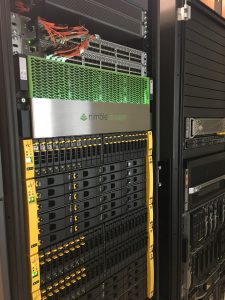
Zunesis – Technology Lab featuring Nimble Storage
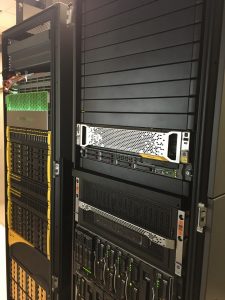
Zunesis Technology Lab
Zunesis has been a Platinum Partner with Hewlett Packard Enterprise (HPE) for 13+ years. As a result, most of the technology in our lab is HPE. Today we have 3 different 3Par Storage Arrays, a Nimble Array, a C7000 Chassis that includes a variety of HPE Servers (Generation 7, 8 and 9) and OneView for overall systems management. The Lab has several Brocade Fibre Channel Switches and Moonshot servers. Within the Lab, we run VMware and Veeam software and have connections to the Microsoft Cloud – Azure. In the coming months, we will be installing new technology in the Lab including:
- Simplivity 2 node
- HPE Gen10 servers
- Aruba switches top of rack
- Extreme network top of rack switches
In the not too distant future, we will replace the C7000 Chassis with an HPE Synergy frame.
Our plans are to continue to invest in our Lab so we can show clients and prospects the actual technology, instead of just talking about it. Furthermore, the Lab is another way we can invest in the on-going technical training and proficiency of our Solution Architects at Zunesis. If you would ever like to stop by for a technology demonstration or just to talk about what you are trying to accomplish in your business, Contact us and would be happy to have you come by for a visit.
In recent months, HPE has announced two acquisitions that significantly impact their online storage portfolio. In January, it was announced that HPE would be acquiring SimpliVity, a leader in the hyperconverged space. Just two months later, in March, we heard that HPE would be acquiring Nimble, a manufacturer of all-flash and hybrid-flash storage solutions backed by a powerful predictive analytics tool called InfoSight. The acquisition of these two solutions gives HPE one of the strongest storage portfolios in the industry.
The HPE online storage portfolio now includes the following:
• MSA
• StoreVirtual (LeftHand)
• Nimble
• SimpliVity
• 3PAR
So, with so many options, the questions you may be asking are, “Where does each fit into my IT Infrastructure?” or “How do I determine which of these is right for my environment?” There is certainly some overlap amongst these options, but there are also clear reasons why you might choose one over the other.
In this post, I want to provide a summary of each of the solutions and include a few thoughts on why you might consider each as a solution for your environment. I will not cover the XP in this post because it is a solution that has a very narrow set of use cases, and most infrastructure needs will be met by the other online storage solutions in the HPE portfolio.
The solutions are organized here from entry-level to enterprise class.
MSA
 The MSA is a family of storage solutions that’s been around for some time and continues to evolve as storage technologies change. This is generally considered an entry-level array. The MSA two controller array offers Block storage over SAS, Fibre Channel, or iSCSI. Despite its entry-level categorization, the MSA is a solution that can provide up to 960TB of RAW capacity and nearly 200,000 IOPS.
The MSA is a family of storage solutions that’s been around for some time and continues to evolve as storage technologies change. This is generally considered an entry-level array. The MSA two controller array offers Block storage over SAS, Fibre Channel, or iSCSI. Despite its entry-level categorization, the MSA is a solution that can provide up to 960TB of RAW capacity and nearly 200,000 IOPS.
In addition to the capacity and performance, this array provides some impressive features, including:
– Thin Provisioning
– Automated Tiering
– Snapshots
– Array-based Replication
– Quality of Service
Consider the MSA if you are trying to meet the needs of a few hosts with a predictable workload profile. This solution is designed with smaller deployments in mind and where affordability is a key factor. If you are looking for deduplication, compression, or plan to scale your environment significantly, the MSA is not for you. We have used the MSA for small VMware environments and as Disk Targets in a backup solution.
StoreVirtual
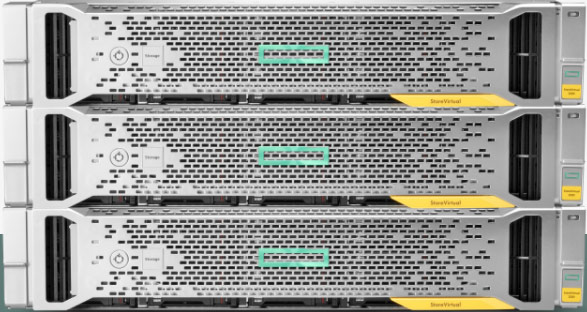 StoreVirtual defines an operating system for providing scale-out, software defined storage solutions. StoreVirtual is based on the LeftHand operating system. LeftHand was a company HP acquired in October of 2008 to give them an iSCSI solution in their portfolio. The LeftHand Operating System is designed to run on most x86-based hardware and can be deployed as a virtual machine, a hyperconverged appliance, or as a dedicated storage array.
StoreVirtual defines an operating system for providing scale-out, software defined storage solutions. StoreVirtual is based on the LeftHand operating system. LeftHand was a company HP acquired in October of 2008 to give them an iSCSI solution in their portfolio. The LeftHand Operating System is designed to run on most x86-based hardware and can be deployed as a virtual machine, a hyperconverged appliance, or as a dedicated storage array.
Regardless of how it is deployed, the StoreVirtual solution provides block storage over iSCSI or Fibre Channel. Capacities can vary depending on the method that is deployed but can go up to 576TB of RAW capacity on the SV3200 Appliance Storage Node.
The StoreVirtual uses an all-inclusive licensing model, and the feature set includes:
– Thin Provisioning
– Automated Tiering
– Snapshots
– Array-based Replication
– Multi-site Stretch Clusters
– Built-in Reporting
Like the MSA, StoreVirtual is intended for smaller deployments with predictable workloads. As a scale-out solution, the StoreVirtual provides an easy path for increasing capacity and performance simultaneously by adding one or more StoreVirtual Nodes. The StoreVirtual solution is a relatively affordable solution for the features it provides. And, if you are looking to take advantage of existing compute and storage hardware, StoreVirtual may be a good choice. We see the StoreVirtual solutions deployed in smaller to mid-sized virtual environments.
SimpliVity
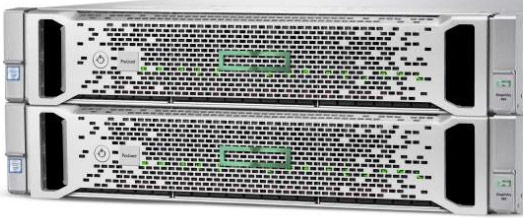 To be clear, SimpliVity is not a standalone, online storage solution. It is a hyperconverged solution that provides Storage, Compute, and Networking services in one converged solution. I am including it in these summaries because it includes storage as an important part of the overall solution and would be an alternative to needing to provide a separate storage solution for your VMware environment.
To be clear, SimpliVity is not a standalone, online storage solution. It is a hyperconverged solution that provides Storage, Compute, and Networking services in one converged solution. I am including it in these summaries because it includes storage as an important part of the overall solution and would be an alternative to needing to provide a separate storage solution for your VMware environment.
SimpliVity is specifically designed to provide all the infrastructure beneath the hypervisor layer. At this time, it is specifically for VMware environments. As a converged solution, SimpliVity provides everything you would need to support your environment. (Yes, that means backup as well!)
Here is a list of the features you’ll find in a SimpliVity solution:
– Servers & VMware
– Storage Switch
– HA Shared Storage
– Backup & Dedupe
– WAN Optimization
– Cloud Gateway
– SSD Array
– Storage Caching
– Data Protection Apps (Backup & Replication)
– Deduplication
– Compression
This solution is going to be more expensive than the MSA or StoreVirtual offerings; but, again, it provides all the infrastructure for your VMware environment. It’s more than just a storage solution. So, if you are looking to consolidate your infrastructure significantly and the workloads you are supporting have all been virtualized on VMware, this solution may be worth looking at for you.
Nimble
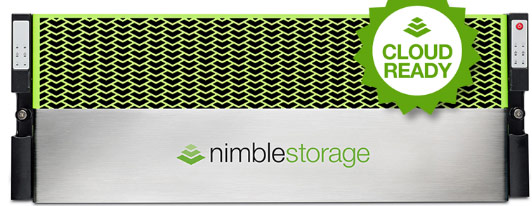 The Nimble solutions offer Block storage in all-flash and hybrid-flash models delivered over iSCSI or Fibre Channel. The current offering from HPE will provide up to 294TB of RAW capacity on the hybrid-flash solution. Of course, compression and deduplication will provide much greater effective capacity dependent on data types.
The Nimble solutions offer Block storage in all-flash and hybrid-flash models delivered over iSCSI or Fibre Channel. The current offering from HPE will provide up to 294TB of RAW capacity on the hybrid-flash solution. Of course, compression and deduplication will provide much greater effective capacity dependent on data types.
The all-inclusive features of the Nimble family include:
– Thin Provisioning
– Automated Tiering
– Application Aware Snapshots
– Deduplication (all-flash)
– Quality of Service (all-flash)
– Array-based Replication
– Encryption
– InfoSight Predictive Analytics
This solution is designed to handle mixed-workloads and is perfect for mid-sized virtualized environments. InfoSight Predictive Analytics is a significant part of this solution, and I wouldn’t be surprised if it were integrated with other HPE storage solutions in the future.
Taken directly from the HPE QuickSpecs, the InfoSight Analytics provide:
– Proactive resolution. InfoSight automatically predicts and resolves 86% of problems before you even know there is an issue.
– Solves storage and non-storage problems. By collecting and correlating sensors across the infrastructure stack, InfoSight uncovers problems spanning from storage to VMs. In fact, 54% of the problems InfoSight resolves are outside of storage.
– Prevents known issues with infrastructure that learns. If a problem is detected in one system, InfoSight begins to predict the issue and inoculate other systems. Every system gets smarter and more reliable through collective installed base insights.
– The support you’ve always wanted. Automation and proactive resolution put the focus on prevention, streamlining the process, and connecting you directly to support expertise. No more answering routine support questions, sending log files, or attempting to recreate issues.
Nimble should be a consideration for any virtualized environment where you are looking for ease of use, great reporting, and performance.
3PAR
 Of course, this has been the workhorse for the enterprise storage offering from HPE since 2010. Depending on the model, the 3PAR Solution can start with 2 Controllers and go up to 8 Controllers for a single array. The 3PAR has both a hybrid and an all-flash solution. Capacities can scale to 6PB RAW in the new 9000 series of the 3PAR family. The 3PAR array delivers Block over iSCSI and Fibre Channel and can also supports SMB, NFS, and FTP/FTPS natively.
Of course, this has been the workhorse for the enterprise storage offering from HPE since 2010. Depending on the model, the 3PAR Solution can start with 2 Controllers and go up to 8 Controllers for a single array. The 3PAR has both a hybrid and an all-flash solution. Capacities can scale to 6PB RAW in the new 9000 series of the 3PAR family. The 3PAR array delivers Block over iSCSI and Fibre Channel and can also supports SMB, NFS, and FTP/FTPS natively.
The all-inclusive feature set includes:
– Thin Provisioning
– Thin Deduplication
– Thin Compression
– Snapshots
– Array-based Replication (add-on license)
– File Persona (SMB, NFS, FTP/FTPS)
– Automated Tiering
– Flash Cache
– Quality of Service
– Non-disruptive LUN Migration
– Array to Array Migration
– Reporting
– Multi-Tenancy
The 3PAR Array should be considered for a multi-workload environment where performance, availability, and scale are the top priorities.
Which One Is Right for You?
As mentioned at the beginning of the post, the goal here was to provide a summary of the primary online storage solutions now offered by HPE and to give a little guidance on where they might fit. Each of these solutions represent a different architecture, and those architectures should be understood clearly before making any final decisions. At Zunesis, we can help you understand which of these solutions might fit your needs and can walk you through the architectures of each.

